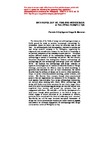Anthropology Of, For, And With Design: A Philippine Perspective
| dc.contributor.author | Maranan, DS | en |
| dc.contributor.author | Cajilig, P | en |
| dc.date.accessioned | 2016-02-03T18:50:41Z | |
| dc.date.available | 2016-02-03T18:50:41Z | |
| dc.date.issued | 2014-11-01 | en |
| dc.identifier.issn | 0118-4857 | en |
| dc.identifier.uri | http://hdl.handle.net/10026.1/4262 | |
| dc.description.abstract |
The intersection of the fields of design and anthropology emerges as fertile ground for study as societies increasingly acknowledge the tremendous impact the objects we create for ourselves have on our lives. As anthropologists and ethnographers involved in running our own design research company in the Philippines, negotiating the alignments and contradictions between the two fields of knowledge is an essential component of our everyday research practice. This paper outlines different models of the relationships between design and anthropology as systems of knowledge and practice. We first extend a theoretical framework that distinguishes between anthropology of, anthropology for, and anthropology with design (Gunn and Donovan 2013): we maintain that anthropology with design underlies an approach increasingly used in commercial industries known as "design thinking", and describe the different ways by which knowledge is generated and mobilized in each of these relationships; we further describe how the artifacts of design can be seen to either materialize, shape, or probe culturally-mediated meanings, power relations, and values. We illustrate these concepts through client-commissioned projects that our organization has conducted in the Philippines. We next examine how and when these design-anthropology relationships are realized when working with clients. While anthropology with design will likely create better outcomes for our clients, larger clients must often settle for anthropology for design; we describe how we have negotiated these tensions and present our outcomes from our engagement with them. We end with a call for the development of a local prism through which practitioners in the field of design can further engage in critical reflection of the production of artifacts, particular those created with the intent of addressing social concerns. Specifically, we call for more localized conceptual frameworks of design that can be patterned (for instance) on India's notion of jugaad, and advance an increased engagement for anthropology with design across various sectors of Philippine society. | en |
| dc.format.extent | 95 - 110 | en |
| dc.language | English | en |
| dc.language.iso | English | en |
| dc.publisher | Ugnayang Pang-Aghamtao/The Anthropological Association of the Philippines | en |
| dc.title | Anthropology Of, For, And With Design: A Philippine Perspective | en |
| dc.type | Journal Article | |
| plymouth.volume | 23 | en |
| plymouth.publisher-url | http://css.pssc.org.ph/viewcategory.php?groupid=6 | en |
| plymouth.journal | AghamTao | en |
| plymouth.organisational-group | /Plymouth | |
| plymouth.organisational-group | /Plymouth/Faculty of Arts, Humanities and Business | |
| plymouth.organisational-group | /Plymouth/Faculty of Arts, Humanities and Business/School of Art, Design and Architecture | |
| dc.publisher.place | Philippines | en |
| dcterms.dateAccepted | 2014-02-28 | en |
| dc.rights.embargoperiod | Not known | en |
| rioxxterms.licenseref.uri | http://www.rioxx.net/licenses/all-rights-reserved | en |
| rioxxterms.licenseref.startdate | 2014-11-01 | en |
| rioxxterms.type | Journal Article/Review | en |


